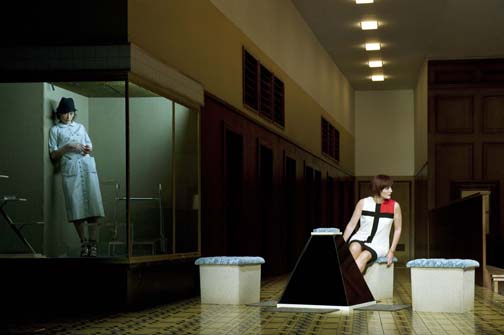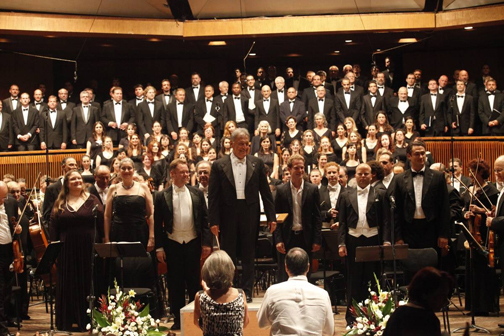Of the three new productions, one was outstanding, one academic and the third traditional.
The 2011 Salzburg Festival featured six full operatic productions. Almost without exception, singers were of the highest standard, which is in keeping with this elitist musical extravaganza. An added attraction was the Vienna Philharmonic Orchestra which was in the pit for 4 of these operas.
Overall the most satisfying of the new productions was the Czech composer Leos Janácek’s Vec Makropulos (Makropulos Case). The question posed in this opera is whether prolonged longevity is such an alluring prospect. The young Emila Marty had been given an elixir to prolong life by her father and was now 337 years old. She had been living under various aliases, all with the initials EM. Now a renowned opera singer, she appears during the concluding moments of a century-long inheritance lawsuit in a family in which she had an amorous relationship with one of the ancestors and mothered a child. To Emilia, the fate of the inheritance is of no consequence. She only wants her father’s written formula to maintain her youth.
The production was directed by Christoph Marthaler with sets and costumes by Anna Viebrock. She divided the huge stage of the Grosses Festspielhaus into sections. The center functioned initially as a paneled lawyer’s office, then as a dressing room at the opera house and finally a courtroom. The glass box on the left had the appearance of an old age home, with two women, one old and the second young and beautiful. At the outset they engaged in an amusing and entertaining silent repartee projected in supertitles in English and German. One question posed was who should decide if a person should live to be over 300 years. Should it be the government or possibly the Swedish Academy? Later, the older women appeared to metamorphose into a younger woman. Were these personifications of Emilia? Further on, the same male admirer returned repetitively to present the same old lady with the same bouquet of flowers. The three act opera was given without any intermission which added to the emotional intensity.

The arduous role of Emilia Marty was taken by soprano Angela Denoke who gave a stunning and impassioned performance. She succeeded brilliantly in portraying the protagonist’s narcissistic character, with disregard for life and humanity, using people solely for her own benefit. Only at the end of the opera in herĺ searing monolog did she come to terms with her age and an element of humanism crept into her character. At this stage Emila decides that she has lived long enough and offers the formula of the elixir to the young Krista, an aspiring singer who nonchalantly lights a cigarette and burns the document. Ms Denoke was well supported by the remainder of the outstanding cast most of whom were under her magnetic spell.
Esa-Pekka Salonen, who recently conducted a great performance of Janacek’s House of the Dead at the Metropolitan Opera, has proved to be a great exponent of this Czech composer and repeated his success here in Salzburg with sumptuous nuanced playing from the Vienna Philharmonic Orchestra. The Makropulos Case was the unquestioned operatic highlight.
Another new production was Richard Strauss’s Die Frau ohne Schatten (The Woman without a Shadow). This fairy tale by librettist Hugo von Hofmannsthal, involves two couples, one celestial (Emperor and Empress) and the other earthly (the dyer Barak and his wife). The Empress casts no shadow (a metaphor for her infertility) and to save her husband from being turned to stone she must acquire one. The nurse, the link between the two couples, takes the Empress to the earthly abode of Barak and his unhappy wife. There she engineers a Mephistophelian plot with Barak’s wife promising the latter riches if she is prepared to relinquish her shadow to the empress. Initially Barak’s wife agrees but subsequently has second thoughts. Even the Empress refuses to accept the shadow, finding the inner strength to determine her own fate.
Christof Loy presented the Salzburg audience with an academic and philosophical production. Designer Johannes Leiacker, staged this opera as a post-World War II recording session in Vienna’s Sofiensäle, the location of many of the famous Decca recordings. This concept was certainly novel but also somewhat controversial. As Loy himself pointed out in a program interview, the Sofiensäle was the site of the foundation of the Austrian Nazi party and was subsequently “a center for rounding up Jews marked for deportation.”
The drama was played out as a recording session with soloists singing their roles into microphones. Dressed in winter coats dating from the 1950’s, they arrived and left the cold recording studio carrying their musical scores. As the drama unfolded there was an attempt of the main characters to act out their roles. Dancers in exotic period costumes with feathers make an appearance as part of the temptation process conjured up by the nurse of what awaits Barak’s wife should she give up her shadow. In the final sequence, the cast appeared in evening attire in a concert setting that included a large Christmas tree, Austrian flags and boy’s choir. The production was without doubt intriguing, but one could not escape the inevitable conclusion that this was merely a glorified concert performance.
There was, however, no question about the brilliant performance of the Vienna Philharmonic Orchestra under Christian Thielemann. He really came to terms with the dramatic score and kept the giant orchestral forces (which comprise 164 instruments) under tight control resulting in glorious sound and never drowned out the singers. Especially notable was the beautiful violin obbligato accompanying the Empress near the conclusion.
Soprano Evelyn Herlitzius portrayed the complex wife most effectively. Anne Schwanewilms was outstanding as the Empress and Michaela Schuster took the role of the sly nurse and made very evident her aversion to humans. Wolfgang Koch, the sonorous baritone sang the role of the Dyer who could not quite comprehend the situation and begged his wife for understanding. Stephen Gould as the Emperor had an imposing ringing tenor whose most arresting moment came in Act 2 where he realized that his wife was associating with humans.
The hottest ticket in the current festival was Verdi’s early opera, Macbeth, conducted by Riccardo Muti. In a press conference, Muti announced that this would be his last Salzburg operatic production which no doubt contributed to the hype. Muti has been a Salzburg favorite for several decades. With him at the helm of the Vienna Philharmonic and his hand picked soloists, an impeccable performance was anticipated and indeed forthcoming. One could not fault his interpretation which was paced far slower than his previous forays into the opera. Muti used Verdi’s early version which ended with Macbeth’s death rather than the traditional victory chorus and also included the ballet scene which is usually omitted. The latter failed to add anything and may even have reduced the dramatic tension.
Peter Stein’s production was conventional and classical. Designer Ferdinand Wögerbauer utilized the large passageway between the orchestra pit and front row seats for King Duncan’s entourage which included brass and woodwind instrumentalists. The same space was later used for the flight of refugees. Another ingenious effect in Act 3 was to project Banquo’s future descendents, in line with the prophesy, to include images of British royalty (Charles I, George III, Victoria, and the current Queen Elizabeth). The opera was staged in the Felsenreitschule (Riding School) which has three magnificent tiers of stone arches. This was effectively utilized when rebel soldiers covered with branches from Birnam Woods emerged from the arches in fulfillment of the witches’ prophesy and engaged in a battle on the giant stage.
Baritone Željko Lučić was an impressive Macbeth especially in the banquet scene when he was accosted by the ghosts of Banquo. Macduff, tenor Giuseppe Filianoti, rose to the occasion when mourning his family (their bloody corpses were displayed on stage). Dmitry Belosselskiy was an excellent Banquo. Pride of place, however, went to Russian soprano Tatiana Serjan as Lady Macbeth. Unlike many sopranos, she was equally effective in both the pianissimo passages as well as when full fortissimo was required. At no time, did she have to force her voice. Her early letter aria was a real tour de force and equally inspiring was her sleepwalking scene where she pulled off the high D-flat with aplomb. The passage of soprano Tatiana Serjan attired in a white night gown across the upper tier of the Riding School in the prelude to her final aria was my most cherished memory of this opera and the festival in general.
Other operas staged included the full Mozart-de Ponte trilogy directed by Claus Guth and a concert performance of Stravinsky’s first opera Le Rossignol and Tchaikovsky’s last opera Iolanta with the incomparable Russian soprano, Anna Netrebko.
Operas are only one aspect of the festival which also includes orchestral concerts, chamber music and recitals. This annual festival appears to go from strength to strength. Over 250,000 visitors from 72 countries attended the 300 events and 95 percent of the tickets were sold, generating an income of over 25 million Euro. The top price for some of the operatic performances was €370. Over 70 percent of the visitors had attended previously indicating that this prestigious festival had built up a loyal base of followers.
Illustrations
Fig 1: View of Salzburg, site of the famous summer festival. Photo Credit Irving Spitz
Fig 2: Soprano Angela Denoke (Emilia Marty) in Janácek’s Vec Makropulos. There is a young woman in the glass box to the left. Photo Credit © Walter Mair
Fig 3: Conductor Christian Thielemann and cast acknowledging the applause after the conclusion of Richard Strauss’s Die Frau ohne Schatten. Photo Credit Irving Spitz
Fig 4: Baritone Željko Lučić (Macbeth), conductor Riccardo Muti and soprano Tatiana Serjan (Lady Macbeth) after the conclusion of Verdi’s Macbeth. Photo Credit Irving Spitz




